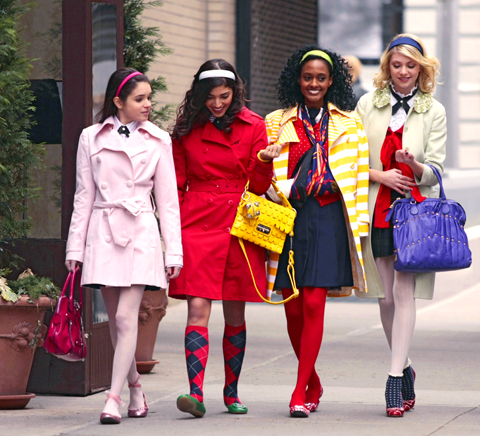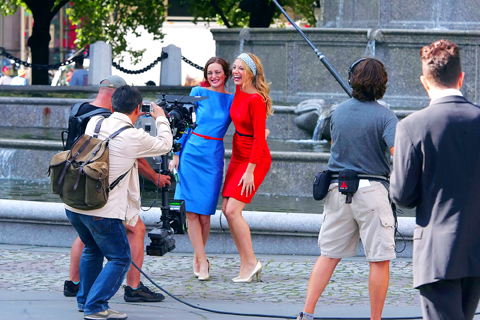Since its debut last fall, Gossip Girl has always been more than a television series about its overt subject, the social machinations of Manhattan private-school students.
It has also presented a cavalcade of fashion, its primary viewership of teenagers and young women tuning in not only for the plots, but also to render judgment on the clothes. The extravagant wardrobes of the stars — a clash of piped blazers, tiny kilts, dueling plaids and festoons of jewelry — have inspired countless posts on fan Web sites, and magazine features about the female leads.
Now the show’s sense of style is having a broader impact, in the retail marketplace. Merchants, designers and trend consultants say that Gossip Girl, which is in summer reruns on the CW network before returning Sept. 1, just in time for back-to-school shopping, is one of the biggest influences on how young US women spend.

PHOTO: NY TIMES NEWS SERVICE
Fans stride into boutiques bearing magazine tear sheets that feature members of the cast and ask for their exact outfits. Or they order scoop-neck tops and hobo bags by following e-commerce links from the show’s Web site.
“The show has had a profound influence on retail,” said Stephanie Solomon, the fashion director for Bloomingdale’s, adding that it appeals not just to teenagers but also to women in their 20s, the daughters and the younger sisters of the generation that made Sex and the City requisite viewing for aspiring glamoristas.
Although the series has had only middling success in the ratings, in stylistic terms it “may well be the biggest influence in the youth culture market,” said Stephanie Meyerson, a trend spotter for Stylesight, a trend forecasting company. The show has given an unexpected mass appeal to patrician staples like crested blazers, layered polo shirts and kilts. When cooler days approach this fall, some retailers are predicting a run on argyle sweaters, knee socks and high boots.

PHOTO: NY TIMES NEWS SERVICE
Thanks to the point-and-click shopping on its Web site and the fees it charges some brands to be featured in the series, Gossip Girl has been able to profit from its power to generate trends. It is not the first show to collect revenues from product tie-ins, but it probably is the first to have been conceived, in part, as a fashion marketing vehicle.
“We tried to launch trends from the get-go,” said Eric Daman, the show’s costume designer, whose resume includes a stretch working with Patricia Field on costumes for Sex and the City.
Now some fall designer collections will also bear a Gossip Girl influence, a trend first seen in February on the New York runways, when the series ignited “a pretty huge resurgence of ritzy, preppy and collegiate looks,” said Amy Astley, the editor of Teen Vogue, citing punky school-girl styles from Marc by Marc Jacobs and Henry Holland, and crested blazers at Ruffian, among others.
Stefani Greenspan, a New York designer whose youth-oriented line, Priorities, is sold at Macy’s, Dillard’s and Bloomingdale’s, acknowledges that Gossip Girl was “definitely part of my inspiration” for a line of trim blazers lined in men’s tie fabric, oversize cardigans and ruffled plaid shirts with gold buttons.
“I like that whole upscale collegiate feeling, mixed with a pair of Louboutins,” Greenspan said. Sales at her eight-year-old company have doubled in the year since Gossip Girl made its debut, she said.
In its 18 original episodes through May 19, the series attracted an average of about 2.7 million viewers, according to Nielsen Media Research. But its clout as a cultural and shopping influence is amplified by the Web, including the show’s own site, which lets viewers identify the brand of the clothes and accessories in each episode and click through to buy them.
“We probably have 50 percent more of our traffic — close to 1 million viewers each month — going into Gossip Girl than into any other show,” said Travis Schneider, the founder of StarBrand Media, which handles the e-commerce connections for the series, along with other shows and films including She’s the Man and America’s Next Top Model.
Covet the top that the character Serena van der Woodsen wears in Episode 12? It’s made by Generra, available for US$68, according to the links from the CW Web site — or it was, before it and other items seen on the show sold out.
Daman, the costume designer, conducted his fashion research at private schools in Manhattan.
“I saw how edgy those girls were, how forward,” he said. “They wore their school uniforms a little shorter, a little tricked out, definitely tailored to fit them perfectly, and they took liberties through their tights and bags.”
The show’s devotees generally fall into two camps: those taken with the worldly nonchalance of Serena (Blake Lively), the show’s queen bee, and others fixated on the fussier style of Blair Waldorf (Leighton Meester), who is given to layering on brooches, pearls, scarves, a shrilly colorful blazer and patent leather pumps, topped with a frilly headband.
Rachel Grinney, the manager of Intermix in Washington, part of a chain of hip boutiques, said many of her young customers scour the store for variations on Serena’s haute bohemian mix of lithe leather jackets with loose-fitting T-shirts and knee-high boots.
Purists dismiss Blair’s look as visual clutter (“You don’t see headbands worn with brooches and necklaces,” scoffed one 16-year-old in the December issue of Teen Vogue), but admirers praise the show’s relative sophistication. “It represents a stylistic departure,” said Sari Sloane, the vice president for fashion merchandising of the 24-store Intermix chain, “a move away from a Hollywood look that was very causal and improvised, to something more polished, more big-city chic.”

April 28 to May 4 During the Japanese colonial era, a city’s “first” high school typically served Japanese students, while Taiwanese attended the “second” high school. Only in Taichung was this reversed. That’s because when Taichung First High School opened its doors on May 1, 1915 to serve Taiwanese students who were previously barred from secondary education, it was the only high school in town. Former principal Hideo Azukisawa threatened to quit when the government in 1922 attempted to transfer the “first” designation to a new local high school for Japanese students, leading to this unusual situation. Prior to the Taichung First

When the South Vietnamese capital of Saigon fell to the North Vietnamese forces 50 years ago this week, it prompted a mass exodus of some 2 million people — hundreds of thousands fleeing perilously on small boats across open water to escape the communist regime. Many ultimately settled in Southern California’s Orange County in an area now known as “Little Saigon,” not far from Marine Corps Base Camp Pendleton, where the first refugees were airlifted upon reaching the US. The diaspora now also has significant populations in Virginia, Texas and Washington state, as well as in countries including France and Australia.

On April 17, Chinese Nationalist Party (KMT) Chairman Eric Chu (朱立倫) launched a bold campaign to revive and revitalize the KMT base by calling for an impromptu rally at the Taipei prosecutor’s offices to protest recent arrests of KMT recall campaigners over allegations of forgery and fraud involving signatures of dead voters. The protest had no time to apply for permits and was illegal, but that played into the sense of opposition grievance at alleged weaponization of the judiciary by the Democratic Progressive Party (DPP) to “annihilate” the opposition parties. Blamed for faltering recall campaigns and faced with a KMT chair

Article 2 of the Additional Articles of the Constitution of the Republic of China (中華民國憲法增修條文) stipulates that upon a vote of no confidence in the premier, the president can dissolve the legislature within 10 days. If the legislature is dissolved, a new legislative election must be held within 60 days, and the legislators’ terms will then be reckoned from that election. Two weeks ago Taipei Mayor Chiang Wan-an (蔣萬安) of the Chinese Nationalist Party (KMT) proposed that the legislature hold a vote of no confidence in the premier and dare the president to dissolve the legislature. The legislature is currently controlled